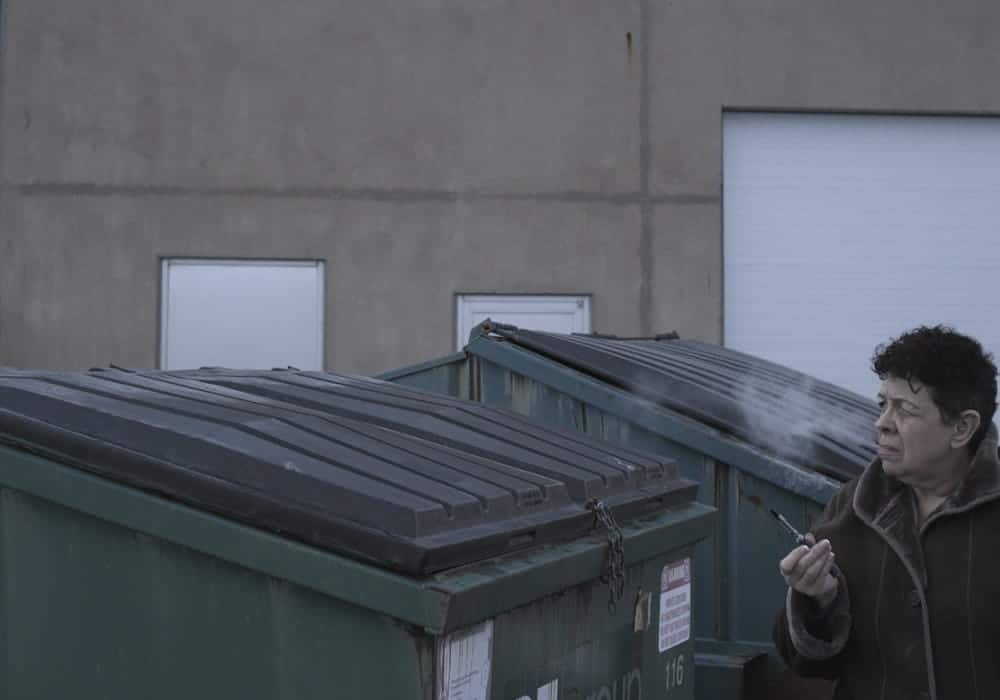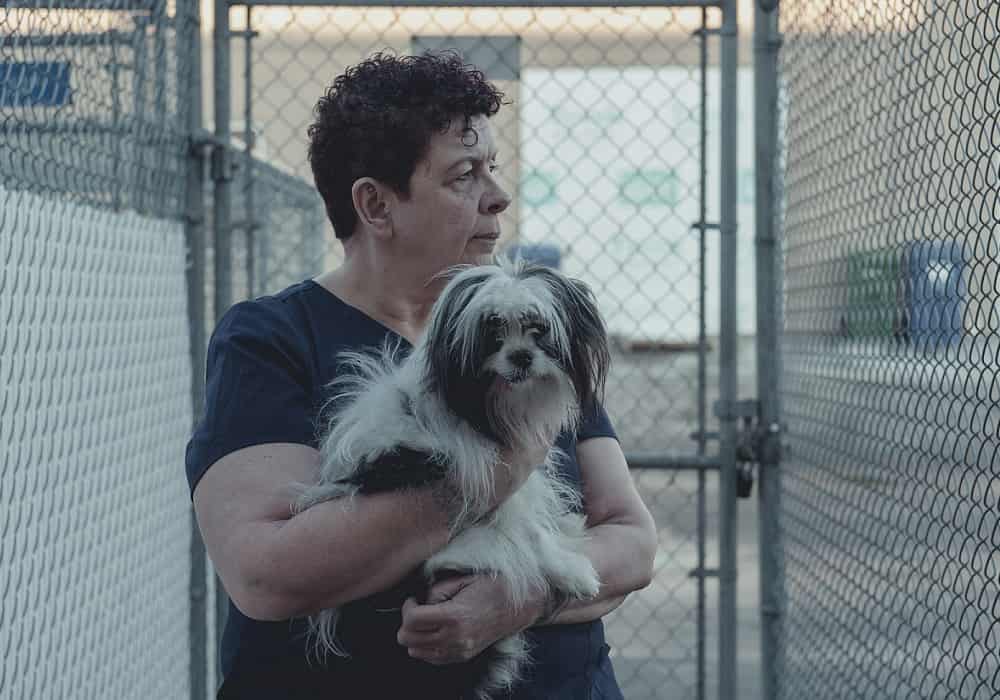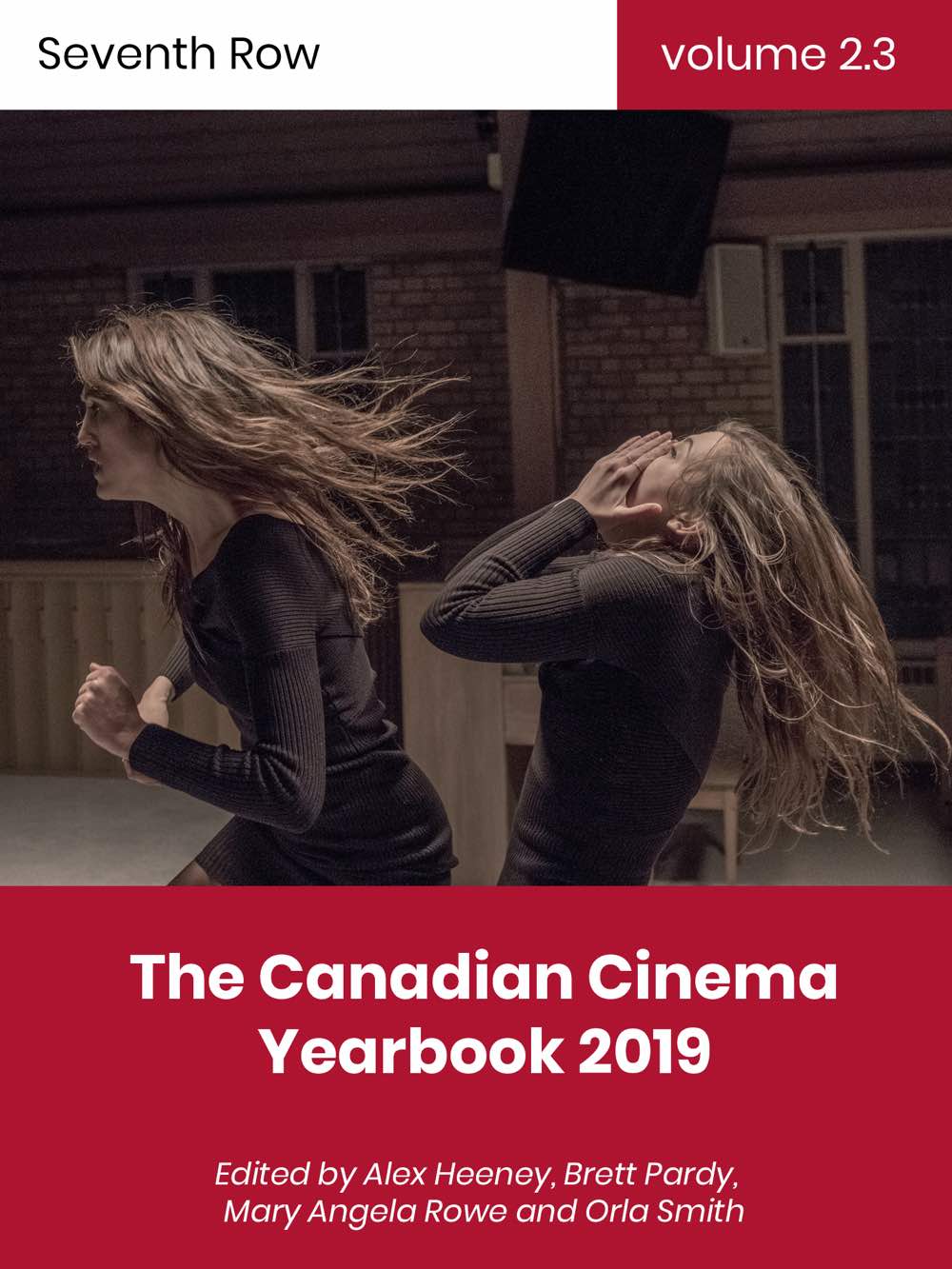Writer-director Heather Young discusses Murmur, her feature film debut, making the transition from shorts to features, working with animals and non-actors, and developing the film’s formal aesthetic. We also interviewed Heather Young about her short film Milk here. Listen to us discuss Murmur on the podcast here.

Halifax-based filmmaker Heather Young first came to our attention in 2017 with her remarkable short Milk, which was part observational animal documentary and part low-key drama: the story of a woman on a dairy farm, who spends her days milking and tending to cows, who discovers she herself is pregnant. The film was particularly sensitive to the relationship between humans, animals, and technology, as well as the sounds of animals and technology.
At TIFF this year, Young makes her feature debut with Murmur, which treads similar territory: a solitary middle-aged protagonist, Donna (Shan MacDonald) starts working at an animal rescue, and ends up taking many of the animals home to fill the companionship void in her life. Shot with pale tones — grey and “the colour of concrete” were Young’s references — that reflect the bleak story on-screen. Donna has no close personal relationships, and whenever she talks to others in the film, usually authority figures, Young keeps them off-screen to emphasize Donna’s isolation.
Before the world premiere of Murmur, I spoke to writer-director Heather Young about telling a story about a single protagonist, working with animals and non-actors, and developing the film’s formal aesthetic.
Seventh Row (7R): What was the genesis of the idea for the film Murmur? How did you decide this was the story that you wanted to tell with your first feature?
Heather Young: It started with a small short film that I made in 2014 called Howard and Jean about my mother and her relationship with her elderly chihuahua, Howard. It was a documentary/fiction hybrid with my mother playing herself, but with some narrative fictional elements that I added in that were about her taking comfort in this little dog and being isolated, but using him as her social outlet.
After that film, I started thinking about what if I took that idea to the extreme? What if an older woman started using pets as her comfort but was never quite satisfied? It never quite quenched this thirst for companionship that she had, so she just keeps getting more animals, and it ends up becoming an addiction.
7R: How did you write the script for a film like Murmur? Part of what’s so unique about this film is for the most part we’re just following this one woman.
Heather Young: I had a traditional script written out for the Telefilm application, although there wasn’t a lot of dialogue written in. I did many drafts of the scripts. Even though I did have a normal script written for the schedule, and all the things based around the script, the difference was no one memorized lines. Some of the performers read it, like Shan [MacDonald], my lead.
None of the performers had ever acted before. One of the things that I find can be intimidating for non-professional performers is having to memorize lines. A lot of times, when they have to say lines that they memorized, it just doesn’t feel authentic because they are trying to act. When I’m working with non-actors, I try to make sure that they are not acting at any time. That’s the most important thing for me: just letting them speak in their own words.

7R: What made you decide you wanted to work with non-actors?
Heather Young: We kind of debated it at the beginning. Martha [Cooley], my producer, and I talked about potentially using real actors. But in my last three short films, I used non-professional actors; it was what I was used to at this point. I’d worked out a way to work with non-professionals that I felt was going okay and that I felt was working for my films. We decided for my first feature there’s already so many big changes going from short [to feature] so I didn’t want to change my working method too much.
7R: What is that process that you came up from? How do you approach working with them aside from you don’t have them memorize dialogue?
Heather Young: That’s the main thing, that they don’t have to memorize dialogue. It’s a lot to do with casting. I try to find people that are emotionally available or very able to easily access their emotions, which I’m looking out for when we’re doing auditions. Or [someone who] isn’t embarrassed to talk about personal things or isn’t embarrassed to show emotion in front of people.
When working with non-professionals, I just try to make them feel comfortable and that there’s no pressure on them. I don’t rush them. I just encourage them to be themselves and not worry too much. We can do this as many times as we want; there’s no pressure.
We work through a scene, and I tell them the different story beats that we have to cover and things that their character has to get across in the scene. I encourage them if there’s two people in the scene to have a real conversation with each other. I always say, if you’re being asked a question in a scene, and you don’t know the answer, just answer from your real life.
For instance, there’s several scenes in the film where Shan, playing Donna, our main character, is seeing an addictions counsellor, and the addictions counsellor asks her a lot of questions. [Shan] was really brave. She would bring parts of her own life into the story. She would often just answer questions really honestly just as herself. She brought herself to it, which was really great.
7R: For the most part, the other characters that Donna interacts with in Murmur don’t appear on screen, or we just see their backs. Even in scenes where she’s having a conversation with somebody, the way you frame it, she’ll be in the part of the frame that’s closest to the person she’s talking to, but there’s a lot of the frame that’s empty: we’re not seeing the other person, and it’s very clear that it’s a choice that we’re not seeing the other person. Where did that idea come from? How did you decide when somebody would be in the frame or when they didn’t belong there?
Heather Young: I hadn’t planned that I was definitely going to do that, where I wouldn’t show the secondary characters. As we were shooting, I had the idea I would like to try that. I think it comes from the idea of this being a portrait film of a specific person. I really liked the idea of always having our focus be on Donna because it’s really about her experience. I really want the audience to empathize with her and what she’s going through.
As these things are happening to her, I want people to look at her face and see her reactions to what they are saying. It became kind of unnecessary to complicate it with other people’s faces. I wanted to focus on her face.It [often[ seems like she doesn’t have a say in what’s happening to her in some ways. I liked the idea of these anonymous characters that feel like they know what’s best, but it’s impersonal. Without seeing them, it emphasizes the impersonal nature of her interactions with these authoritarian figures.
7R: Murmur has a very striking aesthetic. How did you work with your DP and production designer to create that colour scheme and aesthetic for the film?
Heather Young: My director of photography, Jeff Wheaton, and I planned it out quite thoroughly before we started shooting, which was great. He gave me the courage to do things that I was thinking of, but wasn’t sure about. I would be like, “I have this idea,” but then I’d be doubting if we should do it or if it was possible but he’d be like, “We can do that.” He was really encouraging.
When I first suggested shooting in 4:3 aspect ratio, because I feel 4:3 really frames the face nicely, I was like, “Well, you’re probably not going to like this, but I was thinking maybe we can shoot 4:3, but not if it’s too much trouble.” He just immediately was excited and enthusiastic about it. We started doing all this research on 4:3 films and photographers who shoot in that format. We got a lot of great inspirational materials gathered. It was great how enthusiastic he was about that whereas some people would be like, “No, I think we’ll stick to the usual 16:9.”
In terms of the framing, I like to have a restriction or a rule of some kind, not in everything I do, but when I’m lucky enough to have an experienced DP, it’s kind of fun to challenge ourselves with a rule. It makes you think about different ways of doing things and pushes your creativity a bit more. So we decided on a rule after watching Ida (Pawel Pawlikowski, 2013) where the camera doesn’t move. It’s also a 4:3 film, and I really liked the framing choices in that film. We were talking about that film a lot, and he’s like, “What if we also didn’t move the camera?” I was like, ”Oh, we can’t do that! That’s crazy!” But again, Jeff encouraged me and showed me that we could actually do that. I thought it was a great idea, but I wasn’t sure it was possible. He showed me that it was.
We ended up implementing that restriction that the camera can’t move. It was locked down for every shot. It really makes you think about the frame. You have to really like your frame because you are committing to it for the whole shot. That restriction really helped me focus on the detail and the aesthetic of every shot that we had. That was really helpful to bring out some ideas and originality we might not have had.

7R: How did you decide on the colour scheme for Murmur?
Heather Young: I generally have some sort of instinct for what I feel the film should look like when it comes to colour, but it’s usually a very depressing palette. My producer Martha loves bright colours — her favourite colour is turquoise — so she was very disappointed with our dull, kind of depressing colour palette, but I just felt it fit the story. There’s some sadness and some struggle there.
My general rule when it comes to colours is I want natural — nothing too exaggerated or over-saturated. I didn’t want any bright colours, nothing too cheery. My reference colour for the film was grey. I wanted a lot of grey. I remember saying, “the colour of concrete.” That’s also influenced by the locations: the industrial atmosphere of an animal shelter, an animal clinic environment. It’s very sterile, very cold. Where these animals are housed in a shelter environment is not a homey place. It’s practical; it has to be easily cleaned. Just a lot of glass, plastic, and concrete, and these kind of things that can be washed down easily. I did include a bit of colour. We use a little bit of pastel pink and pastel blue in some of the towels and wardrobe, which was nice, but I liked the idea that any colour that we used was desaturated to a certain extent, so the pastels were all a bit desaturated and nothing is vibrantly pulsing with life.
7R: Obviously, there are a lot of animals in the film Murmur. And this is not the first time that you’ve worked with animals. There are some things that feel like almost documentary footage, and there are also lots of scenes of dogs and cats with the main character. What was the process for doing all that because I imagine that there are a lot of challenges in working with that many animals?
Heather Young: It as definitely the big challenge of the film. The main dog in the film, Charlie, is owned by a woman named Gail who runs a dog rescue called Home to Stay in Halifax. She was just the most wonderful, generous, and kind person, who helped us so much with the film. We really couldn’t have done it without her. She not only provided the star dog, but she brought in several of her own dogs as Donna gets more and more animals.
For all the dogs that are appearing together in the film in the apartment, I wanted them to be dogs that already knew each other so it felt like these are dogs that have lived together, spent time together. Also, that way we already know they are going to get along; they are not going to be scared of each other.
What worked out well is Gail is friends in real life with Shan. Shan also has four dogs in real life. She’s a huge dog lover, and Shan has adopted dogs from Gail’s rescue. It worked out that Shan’s dogs and Gail’s dogs already knew each other. We brought in some of Shan’s dogs and some of Gail’s dogs and combined them for the large number of dogs in the film. Otherwise, it would have been too stressful trying to introduce dogs that had never met before.
We did have a dog wrangler on set so there was always someone there to specifically care for the animals, make sure they were taken out for pee breaks, and had water and beds. We only had a couple days where we had the full amount of animals on set. It was usually just Charlie.
Gail has a lot of contacts in the dog community and a lot of friends in the dog rescue community here in Halifax. We needed more dogs than they actually had in the dog shelter where we were shooting, and we needed to film a lot of dogs in their kennels. Gail was like, “You need dogs? No problem.” She reached out to a bunch of people she had adopted dogs from so, by the next day, we had ten people bringing in their dogs for us to film in the kennels in the shelter. She was amazing.
The documentary/veterinary footage, I have a good friend named Susan who is a veterinarian. We are from the same home town, St. John, New Brunswick; she actually plays the veterinarian in the film. She was kind enough to introduce me to her boss at the veterinary hospital. He actually has his own reality show on TV so he was used to cameras being around. He was open to the idea of filming at the clinic. It was kind of a run and gun type of thing. We were filming actual procedures as they were happening. That was a real spay surgery on a female dog, and it was a real dental cleaning on the other dog. It was pretty great, but it was hard because it was all happening quickly. They weren’t going to slow it down just because our crew was filming it. So we had to work fast and make decisions very quickly about what we wanted to film.
7R: How did you think about sound in Murmur? I know it was a very important aspect of your short films.
Heather Young: There were several interesting sounds that came about when we were filming. We mentioned the teeth cleaning and that horrible sound of the instrument grinding against the tooth of one of the dogs, almost like a scream, which I found very interesting and knew I wanted to include — that idea of machine versus body and what kind of sound comes out of that. There were a couple other interesting sounds around cleaning and labour.
I was very interested in filming the labour that goes on in an animal shelter. A long time ago, when I was in my early 20s, I worked in an animal shelter, and I learned there that your job is cleaning mostly. People think that, in an animal shelter, you must just hug and kiss kittens all day long, but really, people who work in these places are pretty much cleaning eight hours a day.
There were a lot of interesting sound and visual elements when it came to the animal shelter: the high pressure sprayers, the squeaks from the squeegees, the drains and water running. We were shooting in an animal shelter that was open to the public, and the employees were just going about their routine. I saw an employee grinding off the sharp pieces of these plastic dog bones. It made an interesting sound, but it was also interesting in that it was such a monotonous, repetitive task. I decided to put that in the film because I wanted to show what labour is like at an animal shelter, and it is very repetitive. And the sound was this horrible grinding between this metal file and these cheap plastic bones. That was a sound that I thought, “This represents what I’m going for!” That was a lucky find.
7R: How did this play out in the editing process for Murmur? Between shooting these real procedures and working with non-actors, I imagine that would pose some challenges to getting the pacing that you want.
Heather Young: The edit was really challenging. I do the editing myself and had been editing my shorts. But I found it a huge leap from editing shorts to editing a feature. It was totally overwhelming. I actually felt that I couldn’t do it, especially at a few points when I first started because I didn’t have anyone helping me. It was just me watching everything by myself. It was quite overwhelming and just the sheer amount of footage, even though we didn’t have an extraordinary amount of footage; I think we shot around 49 and a half hours, which was a lot to tackle alone.
But once I got to an assembly stage, even though it was very long even then, three hours or something, it was like a weight had been lifted. It just started moving a lot faster, and I was able to cut things out quite easily. I remember the first day after I had finally cut every scene and placed them one after another onto the timeline, and it was three hours long: I was like, “Well, OK, there you have it.” But the day after that, I just started cutting. In one day, I cut an hour off the film. Everything just started moving a lot faster once I got to that point.
For me, watching everything for the first time and cutting off the heads and tails and trying to pick out the good parts but seeing the same take over and over again, that part is agony, just agony. Once I finally slogged through that stage, it was much easier and much more enjoyable to edit.
Once we got to a decent rough cut length, I started getting feedback. I would send a link to people that I trusted and that I thought would appreciate the film. I couldn’t have done it without getting feedback from the edit; it gets to the point where you’ve seen it so many times, you can’t be objective anymore, and you need fresh eyes.
Murmur has its World Premiere on 9/6 at 8:45 p.m. (Jackman Hall), and will screen again 9/7 at 3 p.m. (Scotiabank) and 9/15 at 3:30 p.m. (Scotiabank). For tickets, visit the TIFF website here.


